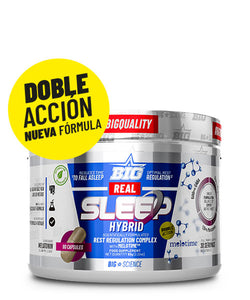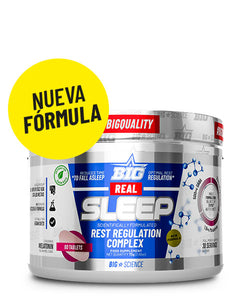
The secret of Morpheus
Sergio Guerrero
INTRODUCTION
If someone is a fan of Greek mythology, they will have deduced what topic we will discuss in this article; Indeed, it is sleep, and the importance it has in the field of not only sports, but health in general. Inadequate sleep is a known risk factor for obesity, diabetes, heart disease and depression.
BIG's Real Sleep is a product to help those people who, with good sleeping habits, feel that their rest is not completely restorative, or people with daily stress that prevents them from being able to sleep. It is important to emphasize sleeping habits since it is the root of the problem in most cases.
Real Sleep is a supplement that, as its name indicates, tries to replace and help improve sleep, but it never replaces or should replace good habits when falling asleep.

ACTIVE PRINCIPLES
- Melatonin
- GABA (Gamma aminobutyric acid)
- Magnesium
- Dry extract of Griffonia simplicifolia (DC.) (Baill.) 5-HTP L-5 Hydroxytryptophan
- Grape dry extract (Vitis vinifera L.)
PATHS OF ACTION
Melatonin
Melatonin is an endogenous hormone produced by the pineal gland and released exclusively at night. Levels in human blood range from 20 picograms per milliliter in the morning to 55 pg/mL in the evening. Light exposure to the retina is transmitted through the suprachiasmatic nucleus (in the hypothalamus) and inhibits melatonin secretion. Therefore, melatonin is secreted in response to periods of darkness, resulting in higher concentrations during the night.
When it comes to understanding sleep, we must know physiological sleep; it is made up of two different states called rapid eye movement sleep (REM) and non-REM sleep (NREM) that alternate cyclically during the night. REM occurs over short periods, characterized by a decrease in muscle tone and associated with profound sympathetic activation, including an increase in heart rate, respiration, blood pressure and temperature. NREM periods are longer and are associated with parasympathetic activation, consisting of low blood pressure, low heart rate, and decreased temperature. Sleep architecture begins to change during middle age, resulting in a dramatic decline in non-rapid eye movement (NREM) slow-wave sleep; In contrast, the amount of rapid eye movement (REM) sleep decreases only slightly. Therefore, reduced melatonin secretion is involved in the mechanism of insomnia. This reduction is more pronounced as we age.
Mechanistically, human endogenous melatonin levels begin to rise approximately 2 hours before the natural onset of sleep and peak approximately 5 hours later. Melatonin and its agonists play an important role in the treatment of insomnia by activating the melatonin receptors MT1 and MT2 (Fig. 1)

- Figure 1: Regulation of melatonin synthesis by the pineal gland in light and dark cycles.
From a pharmacological point of view, it is important that a drug used to treat insomnia or sleep-related disorders not only acts on the duration of sleep, but also preserves the physiological architecture of sleep. Current medications include chloral hydrate, barbiturates, benzodiazepines, benzodiazepine agonists, modafinil, SSRIs, and anxiolytics. However, these medications have substantial side effects , including excessive daytime sleepiness, poor drug tolerance, cognitive impairment, dependence, and withdrawal.
Regarding supplementation with endogenous melatonin, it is mainly metabolized in the liver by hydroxylation (approximately 90%) and is excreted in the urine after conjugation with sulfuric or glucuronic acid.

- Figure 2: Melatonin secretion during a day-night cycle.
Both its concentration and excretion vary, since melatonin can be found with rapid, prolonged or modified action, where modified release causes the concentration in the blood to more closely imitate a natural melatonin profile (Fig. 2), while the immediate release produces a relatively rapid increase in melatonin levels (Fig. 3).

- Figure 3: Pharmacokinetics of immediate-release melatonin and modified-release melatonin. Adapted from Zisapel, 2010 2
GABA
GABA is synthesized in tissues from glutamic acid through the enzyme glutamic acid decarboxylase (GAD), with pyridoxal-5-phosphate (P5P) acting as a cofactor (Fig. 4). Outside the CNS, GABA is synthesized by the microflora of the colon .
As the primary inhibitory neurotransmitter, GABA counteracts overexcitation in the brain and has been described as acting as a "brake" on neural circuitry during times of increased stress. After its release from GABAergic nerve terminals, it acts on GABA A and GABA B receptors, with a net inhibitory effect. Specifically, GABAergic neurons and neurotransmitters regulate brain circuits in the amygdala to modulate stress and anxiety responses in both normal and pathological conditions, cortico-medullary pathways to modulate both rapid eye movement (REM) and Non-REM, particularly slow wave sleep (SWS), and the suprachiasmatic nuclei (SCN) to modulate the circadian rhythm.
GABA A receptors regulate brain excitability and are responsible for the immediate synaptic inhibitory effects of GABA. Since low levels of GABA are associated with anxiety, depression, insomnia, and epilepsy , supplements/medications have been developed that target these GABA receptors.
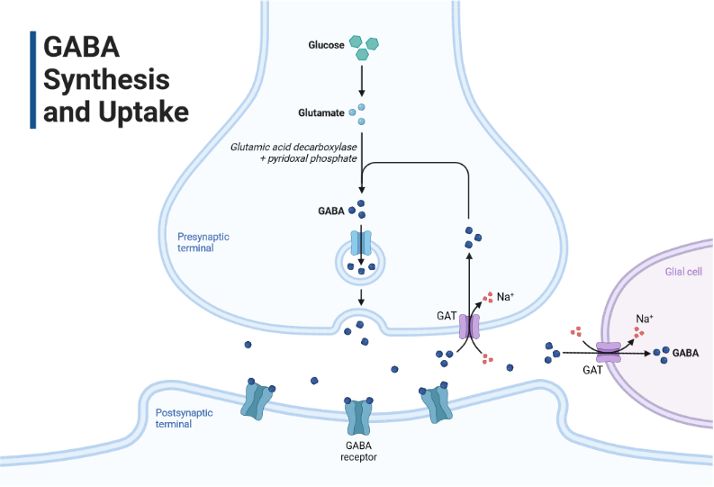
- Figure 4: GABA synthesis
It was long thought that GABA could not cross the blood-brain barrier (BBB) raising questions about the mechanisms of action behind its health benefits. However , there are several studies on BBB and GABA permeability . While some researchers argue that only small amounts of GABA cross the BBB , with the discovery of GABA transport systems in the brain they believe that substantial amounts of GABA could cross the BBB . Furthermore, as GABA is also present in the enteric nervous system , it has been considered that GABA may act on the peripheral nervous system through the gut-brain axis. Although there is some evidence showing that biosynthetic GABA could reach the human brain as demonstrated by various EEG (Electroencephalogram) responses to date, there is no data showing BBB permeability of GABA in humans . Although it has been shown that blood GABA levels were elevated 30 minutes after oral ingestion of GABA as reported by Yamatsu et al., in 2016, it is not known whether oral ingestion of GABA would increase GABA concentrations in the brain. or not. For this, Grape Extract has been added , but we will address this later.

- Figure 5: Influences of GABA synthesis and function.
Magnesium
Magnesium is an essential nutrient for more than 600 processes in the body: it maintains a healthy immune system, regulates muscle and nerve function, ensures stable blood pressure, and keeps bones strong. In addition, it also helps control blood sugar levels and is necessary for the production of protein and energy.
Magnesium is a relatively new treatment recommendation for better sleep, as it plays an important role in sleep regulation.
On a chemical level, it helps in this process by activating the parasympathetic nervous system, the system responsible for calming and relaxing you. First, magnesium regulates neurotransmitters, which send signals through the nervous system and brain. It also regulates the hormone melatonin, which guides sleep and wake cycles in your body, and secondly, this mineral binds to GABA receptors, which we have already talked about and whose function is to calm nervous activity. By helping to calm the nervous system, magnesium can help prepare the body and mind for sleep.
It should be noted that magnesium does not directly influence the levels of Tryptophan, Serotonin, Melatonin or GABA. It simply modulates the affinity of NMDA* and GABA receptors and increases the conversion of tryptophan to serotonin to melatonin (Fig.6).

- Figure 6: Mechanism of magnesium and its actions in sleep regulation
*NMDA: very complex proteins that act as glutamate receptors. At a functional level, NMDA receptors, together with AMPA glutamate receptors, are fundamentally related to two cognitive processes: learning and memory. Glutamate is the brain's excitatory neurotransmitter par excellence.
5-HTP
L-5-hydroxytryptophan (5-HTP) is produced from tryptophan by the enzyme tryptophan hydroxylase (TPH) and its decarboxylation produces serotonin, a neurotransmitter involved in mood modulation, cognition, reward, and learning. ., memory, sleep and many other physiological processes. This serotonin is further transformed into melatonin, which we talked about previously. Therefore, 5-HTP biosynthesis is important and necessary for the production of key molecules such as serotonin and melatonin (Fig. 7).
Plants are a rich source of 5-HTP, especially Griffonia simplicifolia Baill., whose seeds are used for the synthesis of 5-HTP.

- Figure 7: Pathway for the synthesis of serotonin and melatonin from tryptophan.
grape extract
Grape seed extract is a more recent participant in the world of supplementation, although there have been studies since the 1970s on its application to improve blood flow.
Within the family of endogenous gasotransmitters, nitric oxide (NO) is the smallest gaseous intercellular messenger involved in the modulation of several processes, such as blood flow and the control of platelet aggregation, essential for maintaining vascular homeostasis.
Nitric oxide is produced by three isoforms of NO synthases (NOS): endothelial NOS (eNOS), neuronal NOS (nNOS), and inducible NOS (iNOS) [ and mitochondrial NOS (mtNOS).
As we detailed previously, there is mixed evidence regarding the passage of GABA to the blood-brain barrier; for this, grape seed extract, due to its high content of proanthocyanidins, acts by positively regulating the production of eNOS and nitric oxide, thus facilitating the entry of GABA into the blood-brain barrier (BBB) by improving blood flow (Fig. 8).
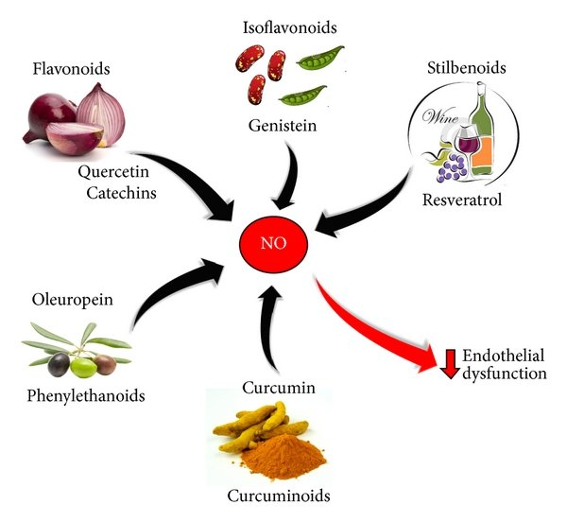
- Figure 8: Polyphenols increase nitric oxide production.
Proof of this is a study carried out by Pimpão, R. et al. in 2015, where 13 subjects were administered a puree rich in proanthocyanidins, a class of polyphenols, where they concluded that, after ingestion and subsequent absorption, polyphenol metabolites were identified in urine and blood plasma. These metabolites, which circulate in micromolar concentrations, cross the blood-brain barrier (BBB).
USE, DOSAGE AND SIDE EFFECTS
Melatonin
Melatonin has been approved in Europe for the treatment of primary insomnia in adults over 55 years of age . Clinical trials have shown that melatonin is effective in treating insomnia in other cohorts, including children with autism spectrum disorders, adolescents with depression, women with premenstrual dysphoric disorder, hypertensive patients taking beta blockers, and children with attention deficit disorder. /hyperactivity.
In a meta-analysis published in 2013 by Oda, E. et. al, where nineteen studies with 1683 subjects were included, melatonin demonstrated significant efficacy in reducing sleep latency (~7 minutes) and overall sleep quality was significantly improved in subjects taking melatonin (Fig. 9). In the same document it is stated that “After performing meta-regressions to evaluate the relationship between effect, duration and dose, higher doses of melatonin and longer duration trials were related to significantly larger effect sizes on sleep latency and total sleep time. These findings suggest that there is no evidence of tolerance development with melatonin use. This is in contrast to other commonly used hypnotics, such as benzodiazepines.”
Regarding doses, the Sleep Foundation recommends an intake of between 0.5 mg-5 mg , however, in Europe, the dose should not exceed 1.8 mg; Therefore, the intake should be individualized by adjusting the dose. Real Sleep contains 1.8 mg per 2-capsule dose . Older adults may find lower doses, starting with 0.1 milligrams, to be safe and effective.
If the intake is of modified, immediate or prolonged action , it should be taken at least 1-2 hours before going to sleep , and preferably with a meal. Drinking alcohol before bed should be avoided , as this can increase the rate of release of melatonin into the bloodstream, effectively converting the modified-release formulation into an immediate-release medication. It is also not advisable to drive or operate machinery for the rest of the night once you have taken melatonin .
Another option, although the manufacturer does not recommend it, is to split one of the long-acting capsules together with another whole modified-release capsule. This causes the split capsule to alter the release profile, thus converting it into an immediate-release capsule. and making the entire dose a modified action, close to the physiological pulses .
Adverse effects associated with the use of melatonin are diverse, but relatively rare . Even at large doses (20-100 mg/day) in healthy volunteers they were well tolerated without safety concerns and without clinically significant changes in any physiological or biochemical measures, Galley HF et Al, 2014. Furthermore, constant use of melatonin produces a very low bounce rate. In fact, in a study published by Sparla,S et al. It was found that patients who stopped exogenous melatonin treatment with a dose of 5 mg recovered their biorhythms on the third day of suspension.
The rate of adverse events in patients taking short courses of modified-release melatonin is reported to be similar compared to placebo and include: asthenia (weakness), headache, respiratory infections, and back pain. It is recommended to avoid melatonin in patients with liver failure. Certain types of medications whose metabolization pathway occurs through CYP1A enzymes should be consulted with a professional before taking melatonin.

- Figure 9: Efficacy of melatonin in reducing sleep latency.
GABA
Natural GABA supplements are produced through a fermentation process using Lactobacillus hilgardii , a bacteria used in the fermentation of vegetables. As an oral supplement, GABA is used for anxiety, depression, stress, insomnia, and PMS. (PMS), epilepsy, blood pressure stabilization, addictions and attention deficit hyperactivity disorder (ADHD) .
GABA A receptor deficits have been found in specific brain regions in patients with generalized anxiety disorder, panic attacks, and post-traumatic stress disorder. Similarly, research shows that patients with depression exhibit reduced brain concentrations of GABA and alterations in the GABA A receptors, with the most pronounced deficits found in patients with melancholic and treatment-resistant subtypes of depression.
Clinical studies using GABA in supplement form show that it induces relaxation, increases alpha brain waves, improves mood, reduces stress markers, and provides anti-anxiety activity in both stressed and healthy subjects. GABA supplementation appears to be fast-acting, with beneficial effects noted within 60 minutes .
An example of this is the study by Murao, Y et Al, in 2012, where 63 adults (28 men, 35 women) were included in the randomized, single-blind, placebo-controlled crossover study for two days of experiment. Oral GABA intake was 100 mg of GABA or placebo each day of the test. EEG activities, including alpha band and beta band brain waves, decreased according to mental stress task loads, indicating that GABA alleviated stress induced by mental tasks. The results indicated a mood-enhancing effect with GABA supplementation, which lasted up to 90 minutes after ingestion .
In another study, this one by Byun et Al in 2018, whose participants received doses of 300 mg 1 h before sleep, they reported that the use of 4 weeks of GABA reduced sleep latency in the GABA group vs. control. Similarly, Yamatsu et al. in 2016, with a dosage of 100 mg 30 minutes before sleep, showed that the 1-week GABA intervention reduced sleep latency and increased total non-REM sleep time in the sleep condition. GABA vs. control.
However, in a previous study with the same dosing regimen, Yamatsu et al. in 2015 only observed a trend toward reduced sleep latency after 1 week of GABA consumption. All three studies failed to show beneficial effects of GABA intake on other sleep markers, such as sleep efficiency, REM sleep time, awakening frequency, etc.
These findings suggest that prolonged intake of GABA (i.e., repeated doses across days) may be beneficial for sleep rather than sleep maintenance, as evidence showed that GABA primarily affects sleep onset and early sleep. stages of sleep that occur early in the night (i.e., the first Non-REM of the night), but not stages of sleep that occur later in the night. This could be explained by the pharmacokinetic profile of GABA , characterized by a rapid increase (30 min after oral administration) and then a decrease (60 min after oral administration) in plasma concentrations. In other words, the rapid elevation of GABA levels in the blood could explain why it affects early markers of sleep differently .
Another trial, this one by Shell, W. et Al. in 2010, prepared a supplement based on GABA and 5-HTP, where 18 patients with sleep disorders were tested. These 18 patients were randomized to the active treatment or placebo group. Sleep latency and sleep duration were measured by daily questionnaires. Sleep quality was measured using a visual analogue scale. Autonomic nervous system function was measured by heart rate variability analysis using 24-hour electrocardiographic recordings.
In the active group, the initial time to fall asleep was 32.3 minutes, which was reduced to 19.1 after supplementation. In the same group, it was also observed that the initial sleep duration was 5 hours (mean), while after supplementation the sleep duration increased to 6.83 h. The difference between the active and placebo groups was significant. Improved ease of falling asleep, awakenings, and grogginess. Objective measurement of parasympathetic function as measured by 24-hour heart rate variability improved in the active group compared to placebo (Fig. 10).

- Figure 10: Sleep latency. Time to fall asleep was assessed at baseline and day 7 using a questionnaire and was measured in minutes.
In the formulation in question, choline in its bitartrate form was used as a precursor to acetylcholine, 5-HTP, derived from Griffonia Simplicifolia extract, was used as a precursor to serotonin and GABA was administered directly as an inhibitory neurotransmitter. Compounds such as Ginkgo biloba were also used to improve absorption, glutamic acid as a neuronal stimulator, cocoa to disinhibit the adenosine brake and grape seed extract, used to avoid the attenuation that is usually associated with the administration of neurotransmitter precursors.
The dosage of GABA is still unclear, but it can be taken in doses as small as 100 mg daily, up to 750 mg 2 or 3 times a day before bed .
As for side effects, there is not enough research to discover the side effects of GABA supplements . The only recommendations are to play it safe and should not be used by pregnant or lactating women; In addition, attention should be paid if antihypertensive medications are used.
Magnesium
Studies have consistently shown that dietary magnesium intake is often inadequate in different countries. In Spain, the Anthropometry, Intake and Energy Balance in Spain (ANIBES) study revealed that the average magnesium consumption in the population was 222 mg/day, which indicates that 79% of the population had an intake of less than 80%. of the national recommended daily dose. The European Food Safety Agency (EFSA) did not consider the available scientific evidence strong enough to determine recommended daily doses and suggested an "adequate intake" of 350 and 300 mg/day for men and women, respectively.
Notably, over the past 60 years, intensive agricultural practices have caused significant depletion of soil mineral content , including a decline in magnesium of up to 30%. Additionally, Western diets typically have a higher proportion of processed foods, where various products are mostly refined, and magnesium is depleted by up to 80-90% in the process.
Factors and behaviors associated with the Western lifestyle, including intense sport and physical activity, poor quality and quantity of sleep, and psychological stress, can also induce magnesium loss (Fig. 11).

- Figure 11: Percentage of the adult population (19 years) with vitamin and mineral intakes below the EAR for individuals (NHANES data 2001–2008). Usual food intakes were estimated using the National Cancer Institute method.
Magnesium supplementation has proven benefits for treating symptoms of daily psychological stress (fatigue, irritability, sleepiness).
It has been shown that people with mental and physical stress can benefit from a daily intake of magnesium . In a study published in 2014, by Zogovic, D. et. Al, male students who experienced common stressors such as sleep deprivation, malnutrition, and lack of physical activity, and who received 250 mg/day of magnesium for four weeks , not only had an increase in magnesium content in erythrocytes, but also a reduction in serum cortisol .

- Figure 12: Possible biological mechanism and logic model underlying how magnesium supplementation influences insomnia symptoms in older adults.
In a recent review and meta-analysis published by Mah, J. et. Al, in 2021, three randomized controlled trials (RCTs) were identified that compared oral magnesium whose daily intake of elemental magnesium ranged from 320 mg to 729 mg taken two or three times a day using two formulations (magnesium oxide and magnesium citrate tablets). magnesium). All interventions were compared with placebo. The duration of follow-up for outcome evaluation ranged from 20 days to 8 weeks. In all studies there were a total of 151 older adults. Pooled analysis showed that post-intervention sleep onset latency time was 17.36 min shorter after magnesium supplementation compared to placebo (Fig. 13).

- Figure 13: Forest plot comparison of magnesium supplementation compared to placebo for sleep onset latency outcome
While it is true that these studies by Heid, 2002 and Abbasi, 2012 present a high risk of bias, the review by Mah, J et al. suggests that “In all results, only by frequency, there was a positive effect of supplementation with magnesium in improving sleep parameters.” “This review confirms that the quality of the literature is poor for clinicians to make well-informed recommendations on the use of oral magnesium for older adults with insomnia. However, since oral magnesium is very cheap and widely available, evidence from RCTs may support oral magnesium supplementation (amounts of less than 1 g given up to three times a day) to improve sleep parameters after "Magnesium supplementation for insomnia symptoms ."

- Figure 14: Forest plot comparison of magnesium supplementation compared to placebo for total sleep time outcome
Therefore, as we have seen, there is magnesium deficiency in a large % of the world population, and, although studies show limited and mixed evidence for the use of magnesium and insomnia, the cost-risk-benefit relationship is very clear. . On the other hand, it has been shown that it is useful for trying to manage stress (Fig.15)

- Figure 15: The vicious cycle of stress and magnesium.
Magnesium supplementation is considered well tolerated , and diarrhea is usually the main manifestation of excessive intake . This depends on the salt to which the magnesium is attached, since we can find it in different forms such as magnesium oxide, bisglycinate, carbonate, chloride, etc.
BIG Science decided to use magnesium oxide, since both the % of elemental magnesium and the milligrams absorbed per 100 mg of salt are higher in this form . The associated intestinal problems are due to ingesting too much in one dose, and taking into account that the capacity of the intestine to absorb magnesium is limited, it will remain in the intestine without being absorbed . Therefore, adjusting the amount of elemental magnesium to be ingested per dose is the best option . It also depends on the person and their tolerability, but doses of between 100-150 mg of elemental magnesium rarely cause problems . Below, I leave a graph taken from an Instagram post by my colleague Carlos Mejías.

- Link to Post:
5-HTP
As we have seen previously, 5-HTP produces serotonin, which can be converted into the hormone melatonin. It plays an important role in regulating sleep and its levels begin to rise at night to promote sleep and fall in the morning to help you wake up. Therefore, supplementing with 5-HTP can promote sleep by increasing your body's production of melatonin.
In the study we saw earlier from Shell, W. et Al. in 2010, it was shown that a combination of 5-HTP and gamma-aminobutyric acid (GABA) significantly reduced the time needed to fall asleep, increased sleep duration and improved sleep quality.
Another recent study from 2021, published by Sutanto, C et al. In a randomized trial, 20 older adults were given 100 mg of 5-HTP daily. They were divided into 2 groups, 10 took the supplement and the rest did not. Sleep quality data were collected every 4 weeks through subjective and objective measures, such as the Pittsburg Sleep Quality Index (PSQI) questionnaire and the actigraphy watch.
The results obtained were that older adults with poor sleep quality who supplemented with 5-HTP helped reduce sleep latency for up to 8 weeks . However, no prolonged effects were observed, and this may be due to the body's acclimatization to long-term 5-HTP supplementation . Therefore, supplementing GABA together with 5-HTP may have a synergistic function .
As for the dose, it depends on the context for which it is required. As this article is focused on sleep, doses between 100 mg and 300 mg are the most common . Doses of up to 400 mg for one year have not shown adverse effects . If they occur, the most common are: heartburn, stomach pain, nausea, vomiting, diarrhea, drowsiness, sexual problems and muscle problems. Large doses of 5-HTP, such as 6-10 grams daily, may not be safe . These doses have been linked to serious stomach problems and muscle spasms.
REFERENCES
- Dulloo AG, Seydoux J, Girardier L, Chantre P, Vandermander J. Green tea and thermogenesis: interactions between catechin-polyphenols, caffeine and sympathetic activity. Int J Obes Relat Metab Disord. 2000 Feb;24(2):252-8. doi: 10.1038/sj.ijo.0801101. PMID: 10702779.
- Feng Z, Wei RB, Hong Q, Cui SY, Chen XM. Grape seed extract enhances eNOS expression and NO production through regulating calcium-mediated AKT phosphorylation in H2O2-treated endothelium. Cell Biol Int. 2010 Oct;34(10):1055-61. doi: 10.1042/CBI20100054. PMID: 20513234.
- Ferracioli-Oda E, Qawasmi A, Bloch MH (2013) Meta-Analysis: Melatonin for the Treatment of Primary Sleep Disorders. PLOS ONE 8(5): e63773. https://doi.org/10.1371/journal.pone.0063773
- Figueira I, Garcia G, Pimpão RC, Terrasso AP, Costa I, Almeida AF, Tavares L, Pais TF, Pinto P, Ventura MR, Filipe A, McDougall GJ, Stewart D, Kim KS, Palmela I, Brites D, Brito MA , Brito C, Santos CN. Polyphenols journey through blood-brain barrier towards neuronal protection. Sci Rep 2017 Sep 13;7(1):11456. doi:10.1038/s41598-017-11512-6. Erratum in: Sci Rep. 2021 Aug 18;11(1):17112. PMID: 28904352; PMCID: PMC5597593.
- Forte M, Conti V, Damato A, Ambrosio M, Puca AA, Sciarretta S, Frati G, Vecchione C, Carrizo A. Targeting Nitric Oxide with Natural Derived Compounds as a Therapeutic Strategy in Vascular Diseases. Oxid Med Cell Longev. 2016;2016:7364138. doi: 10.1155/2016/7364138. Epub 2016 Aug 29. PMID: 27651855; PMCID: PMC5019908.
- Galley HF, Lowes DA, Allen L, et al. Melatonin as a potential therapy for sepsis: a phase I dose escalation study and an ex vivo whole blood model under conditions of sepsis. J.
- Gant, C. E. (2004). The Role of 5 HTP as a Precursor for Serotonin and Melatonin in the Treatment of Anxiety, Panic Disorder, Sleep Disorder, Weight Management, Fibromyalgia, Migraine and Withdrawal from Antidepressant Medication.
- Gobbi G, Comai S. Differential Function of Melatonin MT1 and MT2 Receptors in REM and NREM Sleep. Front Endocrinol (Lausanne). 2019 Mar 1;10:87. doi: 10.3389/fendo.2019.00087. PMID: 30881340; PMCID: PMC6407453.
- Hajak G, Lemme K, Zisapel N. Lasting treatment effects in a postmarketing surveillance study of prolonged-release melatonin. Int Clin Psychopharmacol. 2015; 30:36–42.10.1097/YIC.0000000000000046
- Hepsomali, P., Groeger, JA, Nishihira, J., & Scholey, A. (2020). Effects of Oral Gamma-Aminobutyric Acid (GABA) Administration on Stress and Sleep in Humans: A Systematic Review. Frontiers in neuroscience, 14, 923. https://doi.org/10.3389/fnins.2020.00923
- https://www.sleepfoundation.org/melatonin/melatonin-dosage-how-much-should-you-take
- Maffei ME (2020). 5-Hydroxytryptophan (5-HTP): Natural Occurrence, Analysis, Biosynthesis, Biotechnology, Physiology and Toxicology. International journal of molecular sciences, 22(1), 181. https://doi.org/10.3390/ijms22010181
- Mah J, Pitre T. Oral magnesium supplementation for insomnia in older adults: a Systematic Review & Meta-Analysis. BMC Complement Med Ther. 2021 Apr 17;21(1):125. doi:10.1186/s12906-021-03297-z. PMID: 33865376; PMCID: PMC8053283.
- Matsumoto M, Sack RL, Blood ML, Lewy AJ. The amplitude of endogenous melatonin production is not affected by melatonin treatment in humans. J Pineal Res. 1997 Jan;22(1):42-4. doi: 10.1111/j.1600-079x.1997.tb00301. x. PMID: 9062869.
- Odai T, Terauchi M, Kato K, Hirose A, Miyasaka N. Effects of Grape Seed Proanthocyanidin Extract on Vascular Endothelial Function in Participants with Prehypertension: A Randomized, Double-Blind, Placebo-Controlled Study. Nutrients. 2019; 11(12):2844. https://doi.org/10.3390/nu11122844
- Orser BA. Extrasynaptic GABAA receptors are critical targets for sedative-hypnotic drugs. J Clin Sleep Med 2006;2(2):S12-18.
- Pickering G, Mazur A, Trousselard M, Bienkowski P, Yaltsewa N, Amessou M, Noah L, Pouteau E. Magnesium Status and Stress: The Vicious Circle Concept Revisited. Nutrients. 2020 Nov 28;12(12):3672. doi:10.3390/nu12123672. PMID: 33260549; PMCID: PMC7761127.
- Pimpão RC, Ventura MR, Ferreira RB, Williamson G, Santos CN. Phenolic sulfates as new and highly abundant metabolites in human plasma after ingestion of a mixed berry fruit purée. Br J Nutr. 2015 Feb 14;113(3):454-63. doi: 10.1017/S0007114514003511. Epub 2015 Jan 9. PMID: 25571923.
- Ranade VV, Somberg JC. Bioavailability and pharmacokinetics of magnesium after administration of magnesium salts to humans. Am J Ther. 2001 Sep-Oct;8(5):345-57. doi: 10.1097/00045391-200109000-00008. PMID: 11550076.
- Shell W, Bullias D, Charuvastra E, May LA, Silver DS. A randomized, placebo-controlled trial of an amino acid preparation on timing and quality of sleep. Am J Ther. 2010 Mar-Apr;17(2):133-9. doi: 10.1097/MJT.0b013e31819e9eab. PMID: 19417589.
- Shyamaladevi N, Jayakumar AR, Sujatha R, Paul V, Subramanian EH. Evidence that nitric oxide production increases gamma-amino butyric acid permeability of blood-brain barrier. Brain Res Bull. 2002 Jan 15;57(2):231-6. doi: 10.1016/s0361-9230(01)00755-9. PMID: 11849830.
- Sparla S, Koch BC, Bosma R, Nagtegaal E. Recovery of circadian melatonin rhythm after a melatonin holiday in daytime haemodialysis patients on long-term exogenous melatonin. Funct Neurol. 2018 Oct/Dec;33(4):188-193. PMID: 30663964.
- Sutanto, C., Heng, C.W., Gan, A.X., Wang, X., Fam, J., & Kim, J.E. (2021). The Impact of 5-Hydroxytryptophan Supplementation on Sleep Quality of Older Adults in Singapore: A Randomized Controlled Trial. Current Developments in Nutrition, 5(Suppl 2), 372. https://doi.org/10.1093/cdn/nzab037_082
- Wienecke, E.; Nolden, C. Long-term HRV analysis shows stress reduction by magnesium intake. MMW Fortschr. Med. 2016, 158, 12–16.
- Winsky-Sommerer R. Role of GABAA receptors in the physiology and pharmacology of sleep. Eur J Neurosci. 2009 May;29(9):1779-94. doi: 10.1111/j.1460-9568.2009.06716.x. Epub 2009 Apr 27. PMID: 19473233.
- Xie Z, Chen F, Li WA, Geng X, Li C, Meng X, Feng Y, Liu W, Yu F. A review of sleep disorders and melatonin. Neurol Res. 2017 Jun;39(6):559-565. doi: 10.1080/01616412.2017.1315864. Epub 2017 May 1. PMID: 28460563.
- Yamatsu, A., Yamashita, Y., Pandharipande, T., Maru, I., and Kim, M. (2016). Effect of oral gamma-aminobutyric acid (GABA) administration on sleep and its absorption in humans. Food Sci. Biotechnol. 25, 547–551. doi:10.1007/s10068-016-0076-9
- Yoto A, Murao S, Motoki M, et al. Oral intake of γ-aminobutyric acid affects mood and central nervous system activities during stress conditions induced by mental tasks. Amino acids 2012;43(3):1331-1337.
- Zisapel N. Melatonin and sleep. Open Neuroendocrinol J 2010; 3:85–95.
- Zogović, D.; Pesić, V.; Dmitrasinović, G.; Dajak, M.; Plećas, B.; Batinić, B.; Popović, D.; Ignjatović, S. Pituitary-gonadal, pituitary-adrenocortical hormone and IL-6 levels following long-term magnesium supplementation in male students. J. Med. Biochem. 2014, 33, 291–298.





![CREABIG [Creapure®]](http://bigsupps.site/cdn/shop/products/producto_BIG_creabig_creapure_250g_0noflavour_500x600_8c48a126-a2a2-46a5-9bbd-8763ab82d768_200x.jpg?v=1757315967)



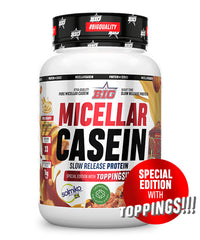
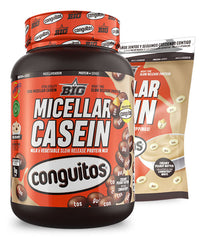
![CFM ISO ZERO [saco]](http://bigsupps.site/cdn/shop/files/producto_cfm_doypack_0noflavour_500x600a_200x.jpg?v=1750981452)
![CLEAR ISO ZERO [750g]](http://bigsupps.site/cdn/shop/files/producto_BIG_clearprotein_icepop_0noflavour_500x600a_200x.jpg?v=1757074297)
![CREABIG FIESTA® KOJAK® flavor - [250g]](http://bigsupps.site/cdn/shop/files/producto_BIG_creabig_kojak_0noflavour_500x600a_200x.jpg?v=1763548822)
